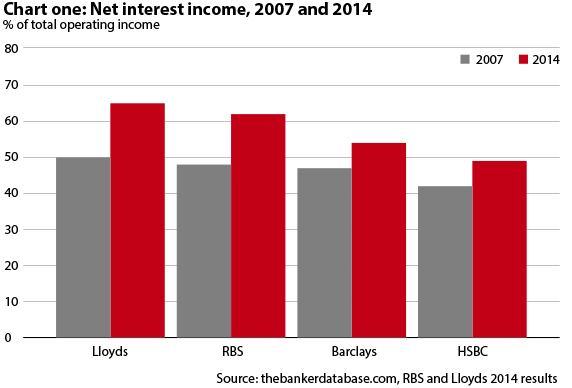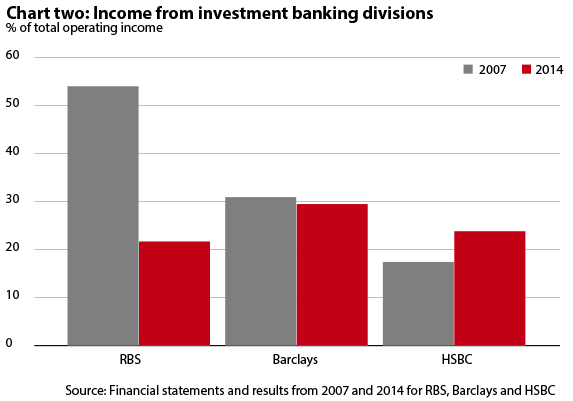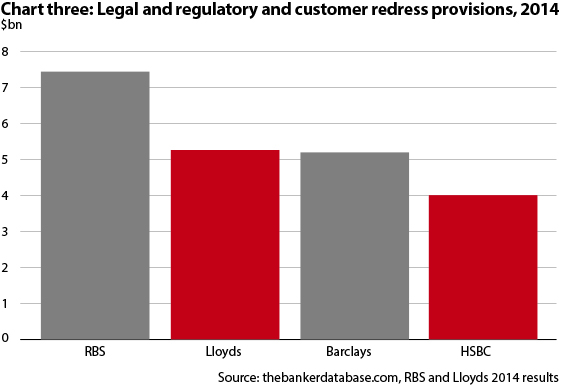UK banks' 2014 results show lenders going back to basics
As the UK's big four lenders release their 2014 results, Matthew Karwacki reports on the insights that these figures offer into the lender's business models.
The UK's four biggest banks – HSBC, Barclays, Royal Bank of Scotland (RBS) and Lloyds – have changed radically since 2007. They are now more dependent on interest income and have retrenched huge parts of the once lucrative investment banking business in favour of more traditional businesses, such as retail and commercial banking.
The banks also have much higher capitalisation – the four now hold $369.18bn in Tier 1 capital, $92.45bn more than in 2007 – along with significant provisioning for legal and regulatory issues along with customer redress.
This new picture emerges by comparing the recently released 2014 results for the banks with the figures from 2007. Although each bank got through the crisis differently, all emerged with reduced employee numbers. As Lloyds and RBS reinvent themselves as leaner and more efficient retail and commercial banks, HSBC and Barclays persist with investment banking models.
Running ahead
Focus on retail and commercial banking was a continuing theme throughout the crisis at Lloyds, but last year the bank’s management doubled down on the agenda, increasing net interest income’s share of total operating income by 15 percentage points from 2007 – to 65%, as can be seen in chart one. Last year, the bank also managed to increase its profitability by pushing up net interest margins by 33 basis points (bps) to 2.45%, which is higher than at any other of the four banks.
Although not a perfect measure, net interest income is a good indicator of the bank’s involvement in traditional banking when compared with total operating income – which in addition to net interest income, includes fee, commission and trading incomes.
The overall business profile of the bank has changed significantly since 2007. Whereas the wholesale division that seated investment banking operations contributed 22.91% of group’s total operating income, it was reduced in size and absorbed by the commercial banking division and is now one of the smaller wholesale divisions in UK.
Following suit
Both the personal and business banking (PBB) and commercial and private banking (CPB) segments at RBS contributed a good performance last year, but the overall results were brought down by losses in corporate and institutional banking and central items and $7.45bn in regulatory and legal provisions.
In 2014, PBB and CPB actually drove 61% of income for RBS, compared with only 37% in 2009. This is consistent with the net interest income figures – net interest income was 62% of total operating income last year, compared with 48% in 2007. This led to gains in the bank’s operating profit – at $5.46bn, it turned around the 2013 operating loss of $12.36bn. Moreover, RBS increased its net interest margin by 22 bps, further increasing profitability of these businesses.
This makes it seem like RBS has made a complete turn around from the way it was structured before the crisis, which is correct – as can be seen in chart two, in 2007, the investment banking arm was responsible for 54.06% of total operating income, while in 2014 that figure dropped to 21.7%.
Although RBS and Lloyds are moving into more traditional activities, it is unlikely that all banks will head in that direction. As Lloyds becomes a more powerful player on the national scene and RBS starts to follow in its footsteps, the competition will be high in a business where margins are already narrow. HSBC and Barclays have both seen their dependence on net interest incomes increase, but both retained profitable investment banking arms, which, however, underperformed last year.
Three’s a crowd
At HSBC interest income’s share of total income rose to 54% last year, from 47% in 2007, however its net interest margins actually dropped from last year, to 1.94%, denting profitability. That figure is lower for Barclays, which depends on interest for only 49% of its income, up by seven percentage points from 2007.
At the division level, HSBC saw its Global Banking and Markets (GBM) division, which is the group’s investment bank, grow as its contribution to total operating income increased five percentage points from 17.44% during the crisis, to 23.84% in 2014. Barclays, on the other hand saw its investment bank’s share of total operating income drop slightly by 1.5 percentage points to 29.5% last year.
For HSBC the growth was accompanied by increased share profits – GBM contributed 31.53% of total profits, up by more than six percentage points since 2007. This was not the case for Barclays, which saw investment bank’s share of profits drop eight percentage points to 25.03% in 2014.
It also appears that investment banking does not inherently lead to high conduct provisions. Chart three shows that of the four banks, HSBC had the lowest legal and regulatory provisions of $4.02bn, while Lloyds had $5.27bn – $3.43bn of which was due to miss-selling of payment protection insurance.
Data for this story was taken from The Banker Database. Find out more about the database, register for a free trial or subscribe today.





